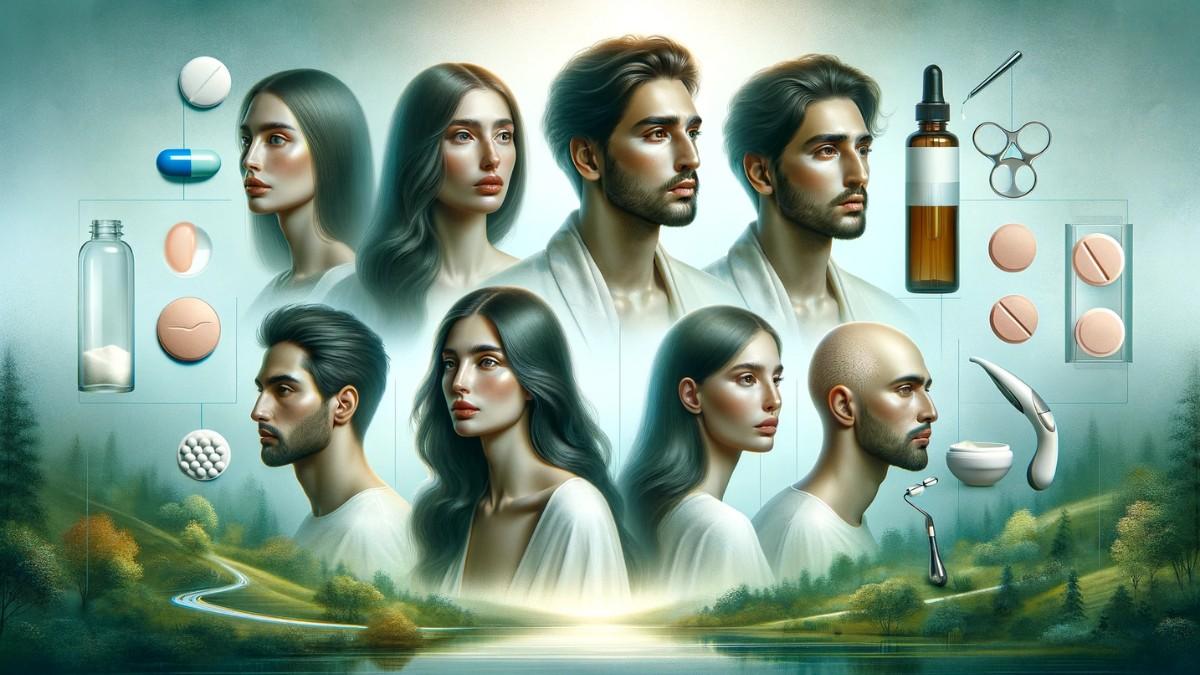Are you among the millions who’ve watched strands of hair thin and fade, echoing the common tale of over half of men by the age of 50? What if the dread of baldness could be replaced with the promise of regrowth? For too long, baldness has been an unwelcome life sentence—a source of diminished confidence and a silent robber of youthful vigor. But now, imagine a world where this is no longer the case, where a groundbreaking cure for baldness isn’t just possible; it’s available. This isn’t just a dream; it’s the reality unfolding before us.
In this article, I will unveil the pioneering treatments that are changing lives, restoring hairlines, and bringing back the confidence that baldness once stole.
However, treatments mentioned below are for informational purposes only and not advisable to be administered without consulting with a certified healthcare professional. Talk to your dermatologist and let them decide the best course of action for your condition.
Minoxidil: A Topical Ally in the Fight Against Baldness
Minoxidil has carved out its reputation as an accessible and effective tool in the arsenal against baldness. This topical medication, initially used for blood pressure control, was found to have a serendipitous side effect: it could regrow hair. This happy accident has since propelled minoxidil to the forefront of hair loss treatments, presenting those affected by baldness with a real chance to turn the tide in their favor.
The inner workings of minoxidil as a cure for baldness are not fully understood, but it’s thought to act by enhancing blood flow to the hair follicles. This increase in blood flow, in turn, improves the delivery of nutrients and oxygen, essentially nurturing the follicles back to health and encouraging hair growth.
Applying minoxidil is relatively simple, involving a twice-daily routine of applying the liquid or foam to the scalp. For optimal results, regular and uninterrupted use is crucial—it’s a commitment to the long game, with results accumulating over time.
Nonetheless, users of minoxidil should be mindful of possible side effects, which can range from scalp irritation to more uncommon systemic effects like a rapid heart rate. Vigilance in observing these potential reactions is essential, particularly in the early stages of treatment.
As for its effectiveness, minoxidil doesn’t promise an overnight cure for baldness but offers a gradual improvement that varies from person to person. Some may experience substantial regrowth, while others may primarily notice the cessation of further hair loss. Despite the variable outcomes, minoxidil remains a staple in the pursuit of hair restoration, offering countless individuals a path to regain both hair and confidence.
Finasteride: A Hormonal Approach to Restoring Hair Growth
Finasteride steps onto the scene as a formidable opponent to baldness, particularly when it comes to male pattern hair loss. It’s a treatment that goes beyond the surface, addressing hair loss at its hormonal source.
By targeting the enzyme 5-alpha-reductase, finasteride prevents the conversion of testosterone into dihydrotestosterone (DHT), the androgen hormone implicated in the miniaturization of hair follicles. The result is a halt in hair loss progression and a potential increase in hair regrowth, especially in balding areas.
Taken orally in tablet form, finasteride is a once-a-day treatment that, due to its prescription nature, is overseen by a healthcare professional. This supervision ensures the treatment is appropriate for the user’s specific condition and allows for monitoring of any side effects.
Speaking of side effects, while finasteride is a beacon of hope for many, it does come with a caveat of potential undesirable effects. Sexual side effects, while not common, are among the most frequently discussed concerns and should be considered when weighing the options for hair loss treatment.
The success rate of finasteride as a cure for baldness is notable, primarily in preventing further hair loss, and secondarily in promoting hair regrowth. Though it’s more preventive than restorative, for those at the onset of their hair loss journey, finasteride can be a powerful measure to maintain existing hair and, in some cases, bring back what’s been lost. Its role in the fight against baldness has solidified its position as a highly regarded option for those seeking a solution to hair loss.
Light Therapy: Illuminating a Path to Hair Restoration
Light therapy, also known as low-level laser therapy (LLLT), is a shining beacon in cure for baldness. It employs red or near-infrared light to initiate a process of cellular rejuvenation and repair. This non-invasive therapy stands out for its use of specific wavelengths of light aimed at stimulating the scalp’s hair follicles.
The principle behind light therapy is rooted in photobiomodulation. The cells within the hair follicles absorb the light energy, which is believed to kick-start the growth phase of the hair cycle, enhance circulation, and reduce inflammation that can lead to hair loss. Essentially, light therapy can potentially ‘wake up’ dormant hair cells and encourage them to begin producing hair once again.
Using light therapy is typically done through devices such as laser combs, hoods, or caps that emit the therapeutic light. These can be used at home, making it a convenient option for many. Treatments are generally recommended several times per week, and like many hair loss interventions, commitment to regular use is critical for seeing results.
Side effects from light therapy are minimal, making it an attractive treatment for those concerned about adverse reactions. The most common complaints are mild scalp discomfort and occasionally, a temporary shedding phase as the hair follicles react to the stimulation by renewing their growth phase.
When it comes to effectiveness, light therapy’s ability to cure baldness varies among individuals. Some users report noticeable improvements in hair density and quality, while others may see more modest results. While not a standalone miracle cure, light therapy has proven to be a valuable part of a multifaceted approach to tackling hair loss.
Derma Roller: A Microneedling Tool for Hair Regrowth
A derma roller is a handheld microneedling device that has gained popularity as an effective tool in the fight against baldness. It features a roller with hundreds of tiny needles which, when rolled over the scalp, create micro-punctures. This minor trauma to the scalp is intended to trigger the body’s wound-healing response, leading to cell turnover and increased circulation to the hair follicles.
How does this translate to hair growth? The microneedles of the derma roller stimulate the scalp, increasing blood flow and the distribution of nutrients to the hair follicles, which can encourage the growth phase in the hair cycle. It also enhances the absorption of topical treatments, such as minoxidil, making them potentially more effective.
Using a derma roller requires some care. Before and after every use, it’s crucial to sanitize the device to prevent infection. Application involves rolling the device over the scalp in various directions, applying consistent but gentle pressure to ensure the needles penetrate the scalp without causing excessive discomfort.
Side effects are generally limited to mild scalp irritation following use and, depending on the pressure applied and needle length, minor bleeding can occur. It’s important to follow instructions carefully to avoid more significant injury to the scalp.
The effectiveness of using a derma roller for curing baldness has been a topic of discussion and research. Users often report that when combined with other treatments like minoxidil, the derma roller can accelerate and enhance hair regrowth outcomes. It’s considered a promising addition to the hair restoration regimen for many, with its ability to bolster the effects of other treatments and its potential to rejuvenate the scalp’s hair-producing capabilities.
ALSO READ | The Rise of Wearable Health Technology: A Revolution in Personal Health and Wellness
Conclusion: A New Era in the Treatment of Baldness
Cure for baldness is more approachable than ever before. With the advent of innovative treatments, those afflicted with hair loss now have tangible hope and a suite of options at their disposal. From the hormone-balancing effects of finasteride to the circulatory boost provided by minoxidil, and from the high-tech promise of light therapy to the mechanical stimulation of derma rollers, the path to hair restoration is varied and ever-expanding.
We’ve traversed the landscape of contemporary treatments, shedding light on the remarkable capabilities of each method. Minoxidil and finasteride emerged as the pharmaceutical frontrunners, offering chemical warfare against the mechanisms of baldness. Light therapy then introduced a futuristic, non-invasive approach to revitalize hair follicles, while derma rollers presented a more hands-on tactic to encourage scalp health and hair growth.
As we reflect on these strategies, it’s clear that cure for baldness is deeply personal and multifaceted. There is no one-size-fits-all solution, but rather a tailored approach that considers the unique biological and lifestyle factors of each individual. The treatments discussed serve not just to combat hair loss, but also to restore the confidence and self-image that is often intertwined with our hair.
In conclusion, the narrative of baldness is being rewritten. No longer an inevitable slide into hairlessness, but a challenge with a growing list of viable solutions. As research advances and new treatments emerge, the prospects for those seeking to reclaim their hair—and with it, a part of their identity—only become brighter.
Disclaimer
The contents of this article, including all text and images related to the cure for baldness, are for informational purposes only. The information provided herein is based on first-hand accounts of individuals who have pursued these treatments and have reported benefits from their use. It is important for readers to understand that these are anecdotal instances and outcomes can vary widely from person to person. There is no absolute guarantee that all readers will experience similar benefits from the treatments discussed.
We strongly advise our readers to consult with a licensed dermatologist or healthcare professional before attempting to use any of the therapies listed and described in this article. Professional guidance is crucial in determining the appropriateness and safety of any health-related treatment for an individual’s specific circumstances.
The author and the publication do not endorse self-treatment and will not accept responsibility for any consequences or adverse effects that may result from the application of the information provided in this article. Any action taken by the reader upon the information found in this article is strictly at their own risk. It is critical to engage in informed discussions with a healthcare provider before making any decisions about hair loss treatments.




